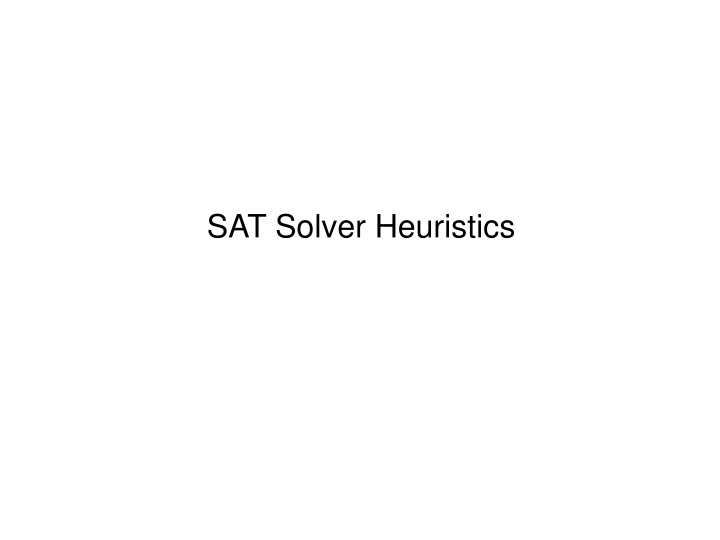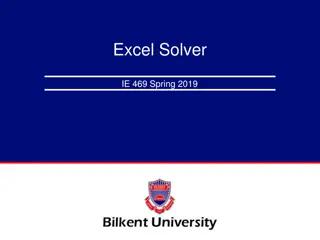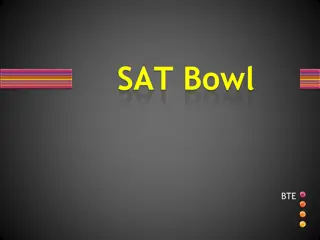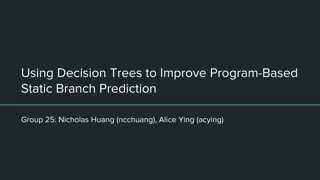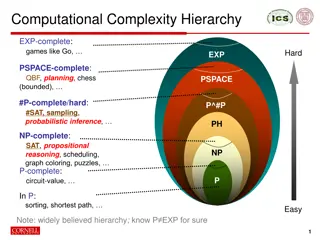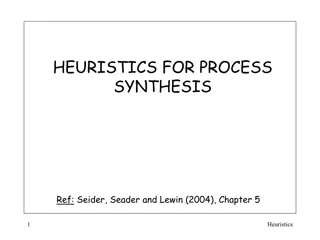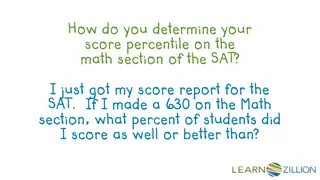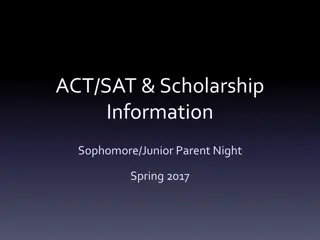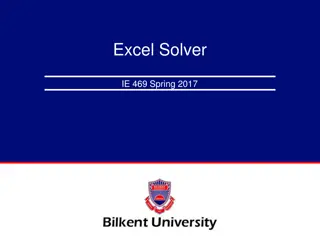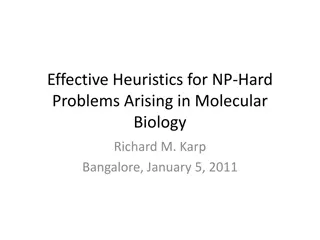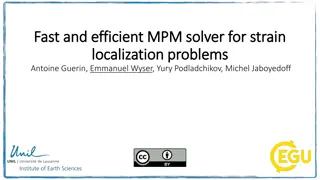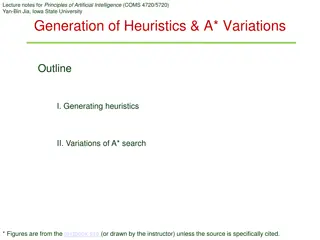Overview of SAT Solver Heuristics and MiniSAT: A Brief Explanation
SAT solvers such as MiniSAT have evolved over the years to efficiently solve propositional satisfiability problems. The history, heuristics, and working principles of SAT solvers are explored in this informative content.
Download Presentation

Please find below an Image/Link to download the presentation.
The content on the website is provided AS IS for your information and personal use only. It may not be sold, licensed, or shared on other websites without obtaining consent from the author.If you encounter any issues during the download, it is possible that the publisher has removed the file from their server.
You are allowed to download the files provided on this website for personal or commercial use, subject to the condition that they are used lawfully. All files are the property of their respective owners.
The content on the website is provided AS IS for your information and personal use only. It may not be sold, licensed, or shared on other websites without obtaining consent from the author.
E N D
Presentation Transcript
SAT-solver History Started with David-Putnam-Logemann-Loveland (DPLL) (1962) Able to solve 10-15 variable problems Satz (Chu Min Li, 1995) Able to solve some 1000 variable problems Chaff (Malik et al., 2001) Intelligently hacked DPLL , Won the 2004 competition Able to solve some 10000 variable problems Current state-of-the-art MiniSAT and SATELITEGTI (Chalmer s university, 2004-2006) Jerusat and Haifasat (Intel Haifa, 2002) Ace (UCLA, 2004-2006) 2/28
MiniSAT MiniSat is a fast SAT solver developed by Niklas E n an d Niklas S rensson MiniSat won all industrial categories in SAT 2005 competition MiniSat won SAT-Race 2006 MiniSat is simple and well-documented Well-defined interface for general use Helpful implementation documents and comments Minimal but efficient heuristic Main.C (344 lines) Solver.C (741 lines) 3/28
Overview (1/2) A set of propositional variables and CNF clauses involving variables (x1 v x1 v x3) (x2 v x1 v x4) x1, x2, x3and x4are variables (true or false) Literals: Variable and its negation x1and x1 A clause is satisfied if one of the literals is true x1=true satisfies clause 1 x1=false satisfies clause 2 Solution: An assignment that satisfies all clauses 4/21
Overview (2/2) Unit clause is a clause in which all but one of literals is assigned to False Unit literal is the unassigned literal in a unit clause (x0) (-x0 x1) (-x2 -x3 -x4) (x0) is a unit clause and x0 is a unit literal (-x0 x1) is a unit clause since x0has to be True (-x2 -x3 -x4) can be a unit clause if the current assignment is that x3and x4are True Boolean Constraint Propagation(BCP) is the process of assigning the True value to all unit literals 5/28
DPLL Overview (1/3) (p r) ( p q r) (p r) p=T p=F (T r) ( T q r) (T r) (F r) ( F q r) (F r) SIMPLIFY SIMPLIFY q r r r 6/28
DPLL Overview (2/3) /* The Quest for Efficient Boolean Satisfiability Solvers * by L.Zhang and S.Malik, Computer Aided Verification 2002 */ DPLL(a formula , assignment) { necessary = deduction( , assignment); new_asgnment = union(necessary, assignment); if (is_satisfied( , new_asgnment)) return SATISFIABLE; else if (is_conflicting( , new_asgnmnt)) return UNSATISFIABLE; var = choose_free_variable( , new_asgnmnt); asgn1 = union(new_asgnmnt, assign(var, 1)); if (DPLL( , asgn1) == SATISFIABLE) return SATISFIABLE; else { asgn2 = union (new_asgnmnt, assign(var,0)); return DPLL ( , asgn2); } } Three techniques added to modern SAT solvers 1. Learnt clauses 2. Non-chronological backtracking 3. Restart 7/28
DPLL Overview (3/3) /* overall structure of Minisat solve procedure */ Solve(){ while(true){ boolean_constraint_propagation(); if(no_conflict){ if(no_unassigned_variable) return SAT; make_decision(); }else{ if (no_decisions_made) return UNSAT; analyze_conflict(); undo_assignments(); add_conflict_clause(); } } } 8/28
Search Space for SAT Formula Ordering xi s: VSIDS Pruning: Learnt clause Guiding: Restart, non-chronological back tracking Suppose that has 10,000 variables x1 T F 10,000 levels x2 x2 T F T F x3 x3 x3 x3 asgn asgn= = {X {X1 1=T, =T, X X2 2=T, =T, X X3 3=T} =T} asgn asgn= = {X {X1 1=T, =T, X X2 2=T, =T, X X3 3=F} =F} x4 x4 x4 x4 x4 x4 x4 x4 210,000assignments (i.e., search space)
Conflict Clause Analysis (1/10) A conflict happens when one clause is falsified by unit propagation Assume x4is False (x1 x4) (-x1 x2) (-x2 x3) (-x3 -x2 -x1) Falsified! Omitted clauses Analyze the conflicting clause to infer a clause (-x3 -x2 -x1) is conflicting clause The inferred clause is a new knowledge A new learnt clause is added to constraints 10/28
Conflict Clause Analysis (2/10) Learnt clauses are inferred by conflict analysis (x1 x4) (-x1 x2) (-x2 x3) (-x3 -x2 -x1) omitted clauses (x4) learnt clause They help prune future parts of the search space Assigning False to x4is the casual of conflict Adding (x4) to constraints prohibit conflict from x4 Learnt clauses actually drive backtracking 11/28
Conflict Clause Analysis (3/10) /* conflict analysis algorithm */ Analyze_conflict(){ cl = find_conflicting_clause(); /* Loop until cl is falsified and one literal whose value is determined in current decision level is remained */ While(!stop_criterion_met(cl)){ lit = choose_literal(cl); /* select the last propagated literal */ Var = variable_of_literal(lit); ante = antecedent(var); cl = resolve(cl, ante, var); } add_clause_to_database(cl); /* backtrack level is the lowest decision level for which the learnt clause is unit clause */ back_dl = clause_asserting_level(cl); return back_dl; } Algorithm from Lintao Zhang and Sharad malik The Quest for Efficient Boolean Satisfiability Solvers 12/28
Conflict Clause Analysis (4/10) Example of conflict clause analysis a, b, c, d, e, f, g, and h: 8 variables ( 28cases) (-f e) (-g f) (b a e) (c e f -b) (-h g) (d -b h) (-b -c -d) (c d) Satisfiable? Unsatisfiable? 13/28
(-fe) (-gf) (bae) (cef-b) (-hg) (d-bh) (-b-c-d)(cd) Conflict Clause Analysis (5/10) Assignments e=F f=F g=F h=F a=F b=T c=T d=T antecedent e=F assumption -f e -g f -h g assumption b a e c e f -b d -b h DLevel=1 a=F Conflict -b -c -d DLevel=2 Example slides are from CMU 15-414 course ppt 14/28
(-fe) (-gf) (bae) (cef-b) (-hg) (d-bh) (-b-c-d)(cd) Conflict Clause Analysis (6/10) Assignments e=F f=F g=F h=F a=F b=T c=T d=T antecedent e=F assumption -f e -g f -h g assumption b a e c e f -b d -b h DLevel=1 a=F -b -c -d DLevel=2 15/28
Resolution Resolution is a process to generate a clause from two clauses Given two clauses (x y) and (-y z), the resolvent of these two clauses is ( x z) (x y) (-y z) is satisfiable iff (x y) (-y z) (x z) is satisfiable The resolvent is redundant 16
(-fe) (-gf) (bae) (cef-b) (-hg) (d-bh) (-b-c-d)(cd) Conflict Clause Analysis (7/10) Assignments e=F f=F g=F h=F a=F b=T c=T d=T antecedent e=F assumption -f e -g f -h g assumption b a e c e f -b d -b h DLevel=1 a=F -b -c h (a resolvent of -b -c -d and d -b h) DLevel=2 17/28
(-fe) (-gf) (bae) (cef-b) (-hg) (d-bh) (-b-c-d)(cd) Conflict Clause Analysis (8/10) Assignments e=F f=F g=F h=F a=F b=T c=T d=T antecedent e=F assumption -f e -g f -h g assumption b a e c e f -b d -b h DLevel=1 a=F -b -c h DLevel=2 18/28
(-fe) (-gf) (bae) (cef-b) (-hg) (d-bh) (-b-c-d)(cd) Conflict Clause Analysis (9/10) Assignments e=F f=F g=F h=F a=F b=T c=T d=T antecedent e=F assumption -f e -g f -h g assumption b a e c e f -b d -b h DLevel=1 a=F -b e f h A final learnt clause since b is the only variable belonging to level 2 DLevel=2 19/28
(-fe) (-gf) (bae) (cef-b) (-hg) (d-bh) (-b-c-d)(cd) Conflict Clause Analysis (10/10) Assignments e=F f=F g=F h=F b=F antecedent e=F assumption -f e -g f -h g -b e f h DLevel=1 a=F b=F -b -c -d -b -c h -b e f h New assign ment@ level 1 20/28
Variable State Independent Decaying Sum(VSIDS) Decision heuristic to determine what variable will be assigned next Decision is independent from the current assignment of each variable VSIDS makes decisions based on activity Activity is a literal occurrence count with higher weight on the more recently added clauses MiniSAT does not consider any polarity in VSIDS Each variable, not literal has score activity description from Lintao Zhang and Sharad malik The Quest for Efficient Boolean Satisfiability Solvers 21/28
VSIDS Decision Heuristic MiniSAT style (1/8) Initially, the score for each variable is 0 First make a decision e = False The order between the same score is unspecified. MiniSAT always assigns False to variables. Variable a b c d e f g h Score 0 0 0 0 0 0 0 0 Value Initial constraints (-f e) (-g f) (b a e) (c e f -b) (-h g) (d -b h) (-b -c -d) (c d) F 22/28
VSIDS Decision Heuristic (2/8) f, g, h are False after BCP Variable a b c d e f g h Score 0 0 0 0 0 0 0 0 Value (-f e) (-g f) (b a e) (c e f -b) (-h g) (d -b h) (-b -c -d) (c d) F F F F 23/28
VSIDS Decision Heuristic (3/8) a is next decision variable Variable a b c d e f g h Score 0 0 0 0 0 0 0 0 Value F (-f e) (-g f) (b a e) (c e f -b) (-h g) (d -b h) (-b -c -d) (c d) F F F F 24/28
VSIDS Decision Heuristic (4/8) b, c are True after BCP Conflict occurs on variable d Start conflict analysis Variable a b c d e f g h Score 0 0 0 0 0 0 0 0 Value F T T T F F F F (-f e) (-g f) (b a e) (c e f -b) (-h g) (d -b h) (-b -c -d) (c d) 25/28
VSIDS Decision Heuristic (5/8) The score of variable in resolvents is increased by 1 Even if a variable appears in resolvents two or mores increase the score just once Variable a b c d e f g h Score 0 1 1 0 0 0 0 1 Value F T T T F F F F (-f e) (-g f) (b a e) (c e f -b) (-h g) (d -b h) (-b -c -d) (c d) Resolvent on d -b -c h 26/28
VSIDS Decision Heuristic (6/8) The end of conflict analysis The scores are decaying 5% for next scoring Variable a b c d e f g h Score 0 0.95 0.95 0 0.95 0.95 0 0.95 Value F T T T F F F F (-f e) (-g f) (b a e) (c e f -b) (-h g) (d -b h) (-b -c -d) (c d) Resolvents -b -c h -b e f h learnt clause 27/28
VSIDS Decision Heuristic (7/8) b is now False and a is True after BCP Next decision variable is c with 0.95 score Variable a b c d e f g h Score 0 0.95 0.95 0 0.95 0.95 0 0.95 Value T F (-f e) (-g f) (b a e) (c e f -b) (-h g) (d -b h) (-b -c -d) (c d) (-b e f h ) F F F F Learnt clause 28/28
VSIDS Decision Heuristic (8/8) Finally we find a model! Variable a b c d e f g h Score 0 0.95 0.95 0 0.95 0.95 0 0.95 Value T F F T F F F F (-f e) (-g f) (b a e) (c e f -b) (-h g) (d -b h) (-b -c -d) (c d) (-b e f h ) Learnt clause 29/28
